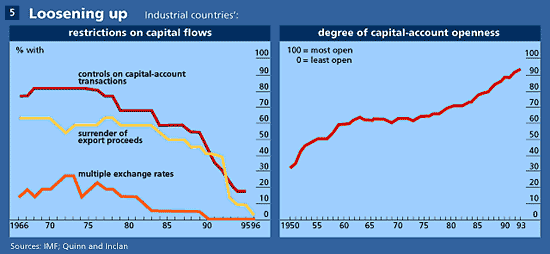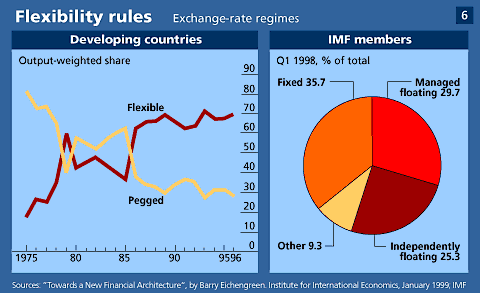

| ||||||
|
| ||||||
AT A casual glance, the IMF’s attitude towards exchange rates seems extraordinarily erratic. In 1997 the Fund urged Asian countries to devalue or float their currencies. In 1998 it lent billions to Russia and Brazil to try to help them maintain their exchange rates. It has praised Hong Kong for its super-strict currency board, and feted Singapore for its flexible managed float. Given that exchange-rate regimes are by definition central to currency crises, such different approaches cannot all be ideal.
They are not, but the IMF’s inconsistency reflects deep divisions about exchange-rate regimes among economists. Tellingly, the official international financial architects (the G7, G22 and so forth) have steered clear of the subject. That is because the exchange-rate issue, more obviously than any other, is mired in the impossible trinity that prevents reform of international finance. It is one area where the trade-offs cannot be fudged.
In a world of increasingly mobile capital (see chart 5), countries cannot fix their exchange rate and at the same time maintain an independent monetary policy. They must choose between the confidence and stability provided by a fixed exchange rate and the control over policy offered by a floating rate. Traditionally, the deciding factor in a country’s choice has been its vulnerability to external shocks, such as sudden shifts in commodity prices. A floating currency allows a country to adjust to external shocks through the exchange rate. In countries with a fixed currency, domestic wages and prices will come under pressure instead.
|
| |
 |
But floating exchange rates have a big drawback: they can overshoot and become highly unstable, especially if large amounts of capital flow in and out of a country. That instability carries real economic costs. Moreover, floating rates can reduce investors’ faith in a currency, thus making it harder to fight inflation. To get the best of both worlds, many emerging economies have tried a hybrid approach, loosely tying their exchange rate either to a single foreign currency, such as the dollar, or to a basket of currencies. Until the recent bout of crises, many academics agreed that such “limited flexibility” was a good compromise.
But that consensus has been shattered. Most academics now believe that only radical solutions will work: either currencies must float freely, or they must be tightly tied (through a currency board or, even better, currency union). Unfortunately the academics rarely agree on the best solution. Take the remedies suggested for Brazil’s ills. Harvard’s Mr Sachs has long been arguing for a floating exchange rate, which the country introduced on January 15th. Rudi Dornbusch, of MIT, is equally adamant that a currency board remains best.
Policymakers prefer to play down exchange rates. Any regime can work, they argue, provided it is backed by sound economic fundamentals. That is true but trite. Of course a country will benefit from sound fiscal and monetary policies; but, as recent events have shown, a country’s choice of exchange-rate regime clearly affects its vulnerability to crises. Asian countries got into trouble because of their exchange-rate pegs, and were then thrown into chaos by the volatility of floating rates.
On the face of it, in a world of capital mobility a more flexible exchange rate seems the best bet. A floating currency will force firms and investors to hedge against fluctuations, not lull them into a false sense of stability (as they were in most of Asia). It will also make foreign banks more circumspect about lending. At the same time it will give policymakers the option of devising their own monetary policy. History, too, is on the side of greater flexibility. Since the mid-1970s the number of countries with flexible exchange rates has increased steadily (see chart 6). All this suggests that the global architects should be promoting, and preparing for, a world of floating currencies. In an excellent new book* on international financial reform, Berkeley’s Mr Eichengreen suggests that the IMF should push countries to adopt floating exchange rates rather than wait until a currency crisis obliges them to.
|
| |
 |
But on closer inspection, the choice is not quite so clear. According to the World Bank, over the past 30 years more crises have befallen countries with flexible than with fixed exchange rates, though they have been more severe for fixed-rate countries. Moreover, monetary independence may be more apparent than real, at least for developing countries with small-scale financial systems. Confronted by sudden market panic, emerging economies dependent on foreign capital have to raise interest rates sky-high to prevent their currency from collapsing.
Mexico is a good example. It has a floating currency, which depreciated by more than 10% in response to the investor panic after Russia’s meltdown. Even so, Mexico’s interest rates were far higher than those of Argentina, which has a super-fixed currency board. In other words, Mexico paid a hefty price to reassure investors that its currency would not go into free fall.
But the biggest problem with a floating currency remains the risk of volatility. As Paul Volcker, a former chairman of the Federal Reserve, likes to point out, the entire banking system of many an emerging country is no bigger than a typical regional bank in the United States (the sort now considered too small for global financial markets, and merging furiously). For many emerging economies, small financial markets mean that exchange-rate volatility will be a structural, not a temporary problem. If a couple of mutual funds suddenly decided to make a serious investment, the country’s exchange rate could rocket, starting an unsustainable boom in the property and banking sector, and causing havoc for exporters.
The more pragmatic proponents of floating rates recognise the risks of volatility. Mr Eichengreen, for instance, wants emerging economies to discourage short-term capital inflows to minimise exchange-rate volatility. He thereby acknowledges that—at least for economies with small financial sectors—floating exchange rates are feasible in the long run only if capital-market integration is slowed down.
Others argue that floating exchange rates make no sense for small emerging economies. Rigidly pegged rates, they reckon, would be far more sensible. Mr Volcker, for instance, has suggested that small emerging economies should seek financial safety and currency stability in “size” and “diversity”. By diversity, he means a good dose of foreign ownership in the financial sector; by size, regional currency arrangements. Emerging markets, he thinks, should link up with the leading regional currency, such as the dollar in the Americas.
This can be done in a number of ways. Currency boards are one option. Hong Kong and Argentina, which both have boards, have shown that they can withstand huge swings in investor confidence—mainly because a currency board forces prudence in the banking system and encourages foreign ownership. A more dramatic step is currency union. Either individual countries can pool their currencies to create a new one (as the Europeans have done), or they can simply adopt the currency of another (Panama, for instance, uses the dollar).
Not long ago, the idea that any economy would voluntarily give up its currency in favour of the dollar was political dynamite. Today the mood is different. Argentina’s president, Carlos Menem, recently asked his technocrats to examine the idea of using the US dollar throughout Latin America. In Mexico, a poll three months ago found that nine out of ten people preferred dollarisation to a floating peso. In private, senior financial officials in Washington suggest that regional dollarisation is a sensible long-term goal. Whether regional currency unions are co-operative (as in Europe) or hegemonic (as they would most likely be in the Americas), they raise tough questions of sovereignty and regulation. In Europe, for instance, responsibility for bank supervision, and the provision of liquidity in the event of a bank panic, will officially remain with national regulators and national central banks. But many national regulators admit that in the event of a serious crisis the European Central Bank would have to step in, and that bank supervision will eventually be handled at the regional level.
In the Americas, it is most unlikely that the Federal Reserve would come to the rescue of an individual Argentine or Mexican bank, so each country would have to build up a safety fund of its own for such purposes. But if a large regional crisis erupted, particularly one that threatened the health of American banks, currency union would make assistance from the Federal Reserve much more likely.
Although regional currency unions will not be formed overnight, they are likely to become an increasingly attractive option in Europe and for some countries in the Americas. Further afield, however, they present more of a problem. Though Asia’s small (and very open) emerging economies would benefit greatly from regional currency stability, nationalist sentiments and mutual suspicion, especially between China and Japan, seem to rule out regional unions.
|
| |
 |
The yen, despite Japan’s current economic difficulties, is clearly the leading Asian currency. But predictions of a “yen block” in Asia seem off the mark. This is partly because Japan’s stifling regulation has frustrated the growth of bond and derivatives markets that might have encouraged other Asians to do business in yen. But political reasons also play a part. Eighteen months ago, when the Asian crisis was still a local affair, the Japanese suggested an Asian monetary fund: a regional self-help group that might provide liquidity for the area’s cash-strapped economies, and perhaps a precursor to a regional currency regime. The idea was firmly squashed by the Americans (who feared a loss of influence), with the support of many South-East Asian countries (which trust Americans more than they trust the bureaucrats in Tokyo). Although Japanese policymakers have recently been talking up the international role of the yen and have even referred again to an Asian monetary fund, this still seems a remore possibility.
The best guess at the moment is that emerging economies will divide into two groups: those with flexible exchange rates and a relatively low level of integration into global capital markets; and those that bind their economies tightly through currency boards or currency unions, and as a result have heavily integrated financial systems with strong foreign ownership. Within a couple of decades, this division could result in two sizeable currency blocks, the dollar and euro zones, together with a large number of countries with floating exchange rates. Different countries will have taken different routes to achieving the “impossible trinity” of integration, regulation and sovereignty. Those in regional unions will have given up sovereignty for integration; those with floating rates will have maintained sovereignty, but often at the cost of restricting integration with the rest of the world.
As part of this evolution, some aspects of international financial organisation will become easier. Global financial regulation, for instance, will become more feasible once regional supervision and regulation have been established within currency blocks. Reaching global agreement will become less cumbersome as the number of participants in negotiations falls. The IMF’s job, in principle, might become simpler if regional central banks played a larger role in providing emergency liquidity within their blocks. Economies remaining outside regional currency unions would have floating exchange rates, reducing the likelihood of large-scale liquidity crises.
Clearly, exchange-rate regimes are central to the debate about global architecture. Emerging economies’ choices between fixed and floating currencies can make a huge difference to the way the international financial system develops. The architects ignore them at their peril.
* “Toward a New International Financial Architecture: a Practical Post-Asia Agenda”, by Barry Eichengreen. Institute for International Economics, Washington DC, January 1999
| Copyright © 2003 The Economist Newspaper and The
Economist Group. All rights reserved. |